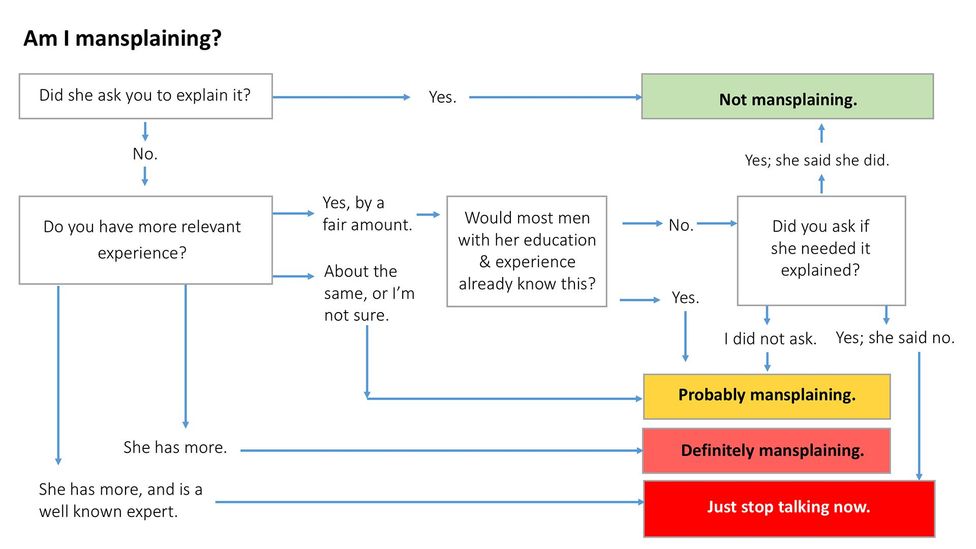A couple of years ago, I was at a discussion table where we were talking about women in public spaces. While talking about how women feel unsafe and how men are gatekeepers of public spaces, a man takes the mic and starts talking about how women should reclaim it. He said that women should be okay with being stared at because, it’s only staring, and that this is the only way women can have access to public spaces.
Another encounter with a man led to a discussion about mental health. Knowing that I am in the mental health field, he decides to explain to me what mental health is and what the problem with this generation is.
Has a similar situation happened with you? This is mansplaining.
Mansplaining is a blended word. It comes from the colloquial word splaining (from ‘explaining’.) It describes the situations where men ‘explain’ things to a woman. Usually, in a condescending way, assuming that womxn don’t know enough about the subject. Even when womxn are leading experts in their respective fields.

What exactly is mansplaining?
The idea of mansplaining came about when Rebecca Solnit wrote her essay, “Men Explain Things to Me: Facts didn’t get in their way.” She talks about a man whom she met at a party. While discussing her latest book, the man decided to cut her off. He asked her if she knew of the new book [on the same topic] that came out. Solnit’s friend tried to explain to the man that it was, indeed, her book. But to no avail. She then writes,
Every woman knows what I’m talking about. It’s the presumption that makes it hard, at times, for any woman in any field; that keeps women from speaking up and from being heard when they dare; that crushes young women into silence by indicating, the way harassment on the street does, that this is not their world. It trains us in self-doubt and self-limitation just as it exercises men’s unsupported overconfidence.
Men explain Things to Me: Facts Didn’t Get in Their Way. Rebecca Solnit, 2008.
However, Solnit is falsely credited with the creation of the word. She merely stated the idea of mansplaining. It was one of New York Times’ words of the year in 2010. The word spread like wildfire as many womxn related to this experience and it accurately describes this phenomenon.
It is used by many men to assert their dominance in any space they occupy.

Mansplaining is a tool that undermines a womxn’s achievements and their expertise. It is a gendered form of gas-lighting which works against womxn. It is the problem that is perpetuated by patriarchy. Patriarchy pushes the idea that womxn need to be saved and helped at every step of the way.
It is the result of two myths of patriarchy: that men know everything and that womxn need help with everything.
Famous examples include: Ranbir Kapoor mansplaining Katrina Kaif’s character in the movie Jagga Jasoos.

Womxn get interrupted everywhere. There is a study that shows that over a three-minute conversation men interrupted their male conversation partner twice, on average, and interrupted the woman 2.6 times. The intent to dominate conversations is apparent. This behavior is all too well known for womxn.
Mansplaining has many, many forms, including verbal and non-verbal behaviours. One of the most common methods of mansplaining is telling a womxn whether they’ll like something. This means urging someone to try things that they love because they’re sure that womxn will like it too. If a womxn doesn’t like beer, men will say ‘oh you haven’t tried the best one yet’ or that ‘you will like it I promise, just have this one.’
How does one know they’re mansplaining?
Kim Goodwin was asked by her male colleagues if they’re mansplaining so she came up with a flow chart that makes it easy to know:

It’s fairly simple to know:
#1. Did they ask you for an explanation?
This is direct. If you explain something without anyone asking for it, you’re mansplaining. It means that you’re trying to hijack that conversation and undermine a womxn’s expertise and knowledge. Simply wait before explaining.
#2. Do you have more experience in the field/subject?
This means…do you have relatively more expertise on the subject? Did you study it for years and worked in the field? It’s NOT mansplaining if you’re the boss/advisor and if it’s coming from the intent to help, not to undermine someone’s success/thought process. But it’s definitely mansplaining when you’re speaking over her while she has more experience or about the same experience you do.
#3. Did you ask if your opinion is needed?
It’s mansplaining if you give your opinions without someone asking you for it. If you interrupt someone during meetings, it is mansplaining.
Mansplaining is everywhere. In actions, during meetings, during dates. It’s almost inescapable and it affects womxn’s self-esteem. We have to do twice as much to get half the recognition men already get. It’s a difficult place to be in. However, we need to start reclaiming our spaces. It’s tough work but phrases like, “I wasn’t done speaking.” or “As I was saying before I was interrupted.” should be used whenever a man speaks over you. “I wasn’t done speaking.” is also a phrase to use. It is tough at first but it’s also necessary to speak for ourselves.
It is a result of years of brainwashing and being held as saviors for womxn that gives men the audacity to speak over everyone. This is not new, it is the trope that is as old as the hills. However, now we have a term for it. Something that describes this perfectly. And with defining it comes the power to spread awareness and to reclaim and assert your presence in the room. This time, we don’t have to stay quiet.
—
Omaiha Walajahi
Writer
Pause for Perspective
